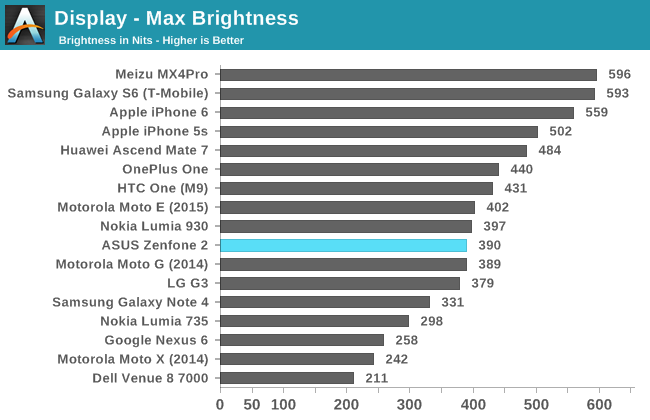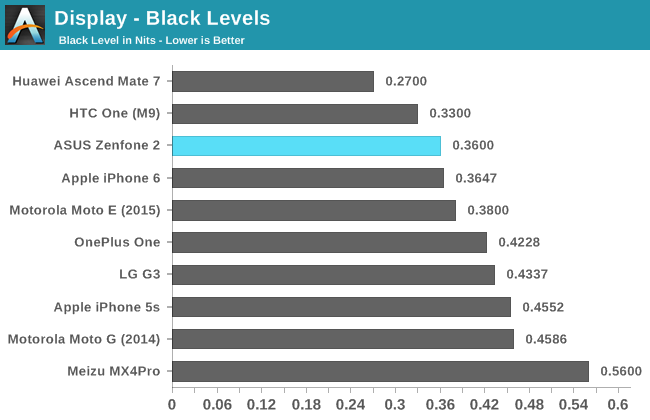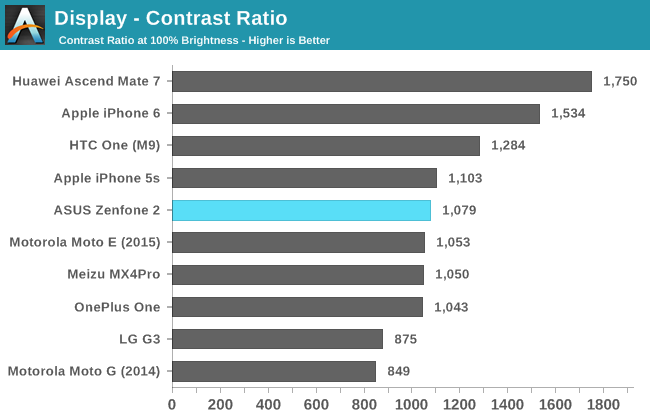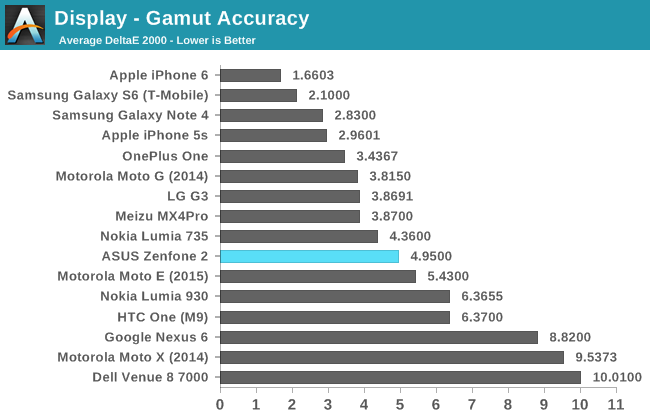The ASUS ZenFone 2 Preview
by Brandon Chester on May 18, 2015 2:00 PM ESTDisplay
I thought it would be important to give potential buyers some idea of how good the display is on the ZenFone 2. On paper it looks very good, as it's a 5.5" 1920x1080 IPS display. The pixel density isn't as high as the latest generation of 2560x1440 panels, but I find that with an RGB stripe panel the difference between 1920x1080 and 2560x1440 is minimal even at 5.5".


The ZenFone 2 appears to be off to a good start. Black levels are very low among our LCDs, and the max brightness is somewhat low but not terrible by any means. I never had any issues when using the ZenFone 2 outside, although it was definitely not as comfortable as the Galaxy S6.

The slightly low max brightness and above average black level results put the ZenFone 2 right in the middle of our LCD devices when it comes to contrast ratio.
Unfortunately, these numbers are somewhat misleading. This is because the ZenFone 2 makes extremely heavy use of dynamic contrast and contect adaptive backlighting. I have never used another device with such dramatic shifts in backlight power. The best example I've found is when switching from an all black to all white screen at max brightness. While this is obviously an extreme case, it illustrates the behavior that is occuring very well. At the moment you switch to white, the brightness of the display is around 170 nits. Over the next few seconds, that brightness rapidly increases to the 390 nits you see in the results above. This is an enormous jump in brightness, and it's very easy to see with your own eyes.
One last thing I'd like to note about the brightness is that the 100% setting on the built in brightness slider is not actually the max brightness that the display is capable of. The max you can achieve using the slider in the Settings app is 319 nits, which is around 82% of the 390 nit result you can get using applications like Brightness Adjuster from Google Play.

The gamut results are unfortunately not as good as what we've seen from the latest generation of smartphones. The DeltaE for red, blue, and magenta are all just over three, while the remaining three colors are around five. The high error in white also contributes to the higher than optimal overall error.
The complete review of the ZenFone 2 should be posted in the near future, and it will include the remainder of our display workflow. The heavy use of CABC and dynamic contrast has a large impact on the display's performance in some of our tests, and so I'll also be elaborating on where and why that occurs, and what it means for the user. For anyone who really wants to order the ZenFone 2 now, I'll conclude by saying that it's definitely not perfect, but it's still a good display. I think it's by far the nicest one you'll find on a phone that starts at $199 purely because of its resolution.











139 Comments
View All Comments
Brandon Chester - Monday, May 18, 2015 - link
You have to consider that you also get 64GB of NAND and 4GB of RAM. I would say it's worth it because of the storage, not the SoC. If you can live with 16GB I would get the base model.tipoo - Monday, May 18, 2015 - link
They all have MicroSD though - if storage is your only concern, you could aways get the 16GB and get a big cheap microSD cardStormyParis - Monday, May 18, 2015 - link
Same as other answer: the RAM and Flash may make it worth it, the MHz don't.MarkLuvsCS - Tuesday, May 19, 2015 - link
The $199 version does NOT include the quick charger which is probably a $10 value right there. I think unless money is really tight the $299 version with more RAM, NAND, and included quick charger is worth the $100 difference.testbug00 - Tuesday, May 19, 2015 - link
for future proofing RAM and the extra storage? Yes. I would say it's worth it. Of course, if you know you're going to upgrade and the phone won't get used in 1-2 years, I wouldn't bother.StormyParis - Monday, May 18, 2015 - link
Regarding the placement of the power button, I'm more intrigued than doubtful: if the phone has double-tap to wake, I'll never use it to wake the phone anyway, and I barely ever use it to switch the screen off. Rather, it'll make it easy to adjust the volume while playing music with the phone in my pocket, though my fingers are getting good at remembering where those volume buttons are anway... not having the power button right next to them is probably good.StormyParis - Monday, May 18, 2015 - link
Reading the comments, I feel lucky to live in Europe where all phones work with all carriers :-pBMNify - Monday, May 18, 2015 - link
Not only France/Europe, Most of the world works in the same way, unlocked phones which work with all telecom operators.lilo777 - Monday, May 18, 2015 - link
US is seemingly turning around on this issue as well. Nowadays it's not so much the carrier locking that is a problem as the use of legacy 3 networks (CDMA) by Verizon and Sprint.Peanutsrevenge - Monday, May 18, 2015 - link
Does it come with a mini JJ? :)